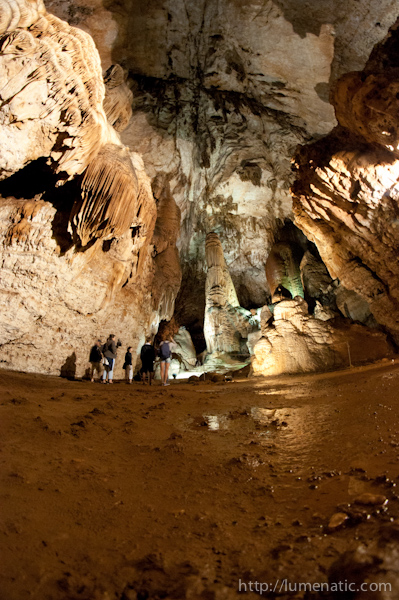Sardinia is an island with many spectacular caves. Two of them I visited, the southeastern Grotto su Marmuri and the mid-south-western Grotto su Mannau.
These caves are huge, sporting a roof ceiling of 70 m at the biggest point. The stalactites and stalagmites come in all sizes – a few cm to a few meters. The caves are also incredibly old. The stalactites speak their own language – to grow 1 cubic centimeter it takes 100 years. Do the math.
To illustrate the vastness of these underground structures nothing else than the trusted 8 mm Samyang lens could come into question.
Things to consider when shooting in such caves:
Low light conditions. It’s underground. Yes, it’s dark. Only the installed lamps illuminate the scenery. So here the classic low-light recipe is once again your choice. Wide open aperture, high ISO, tripod.
Halt Stopp ! In this particular case, namely the 8 mm Samyang, wide open aperture does not work. Except you like blurry pictures which look like you have had too much to drink and then smeared a pound of good German butter on the lens….
At f3.5 the pictures are very blurry at the Samyang, gradually getting better when you close the aperture. To get decent results f8 is necessary. Which means you need high ISO, 3200 and up.
A tripod would be perfect, but the handling and setup for a tripod shot is incompatible with guided tours. So I trusted the old motto “The world is my tripod”, pressing the camera against a wall, in a niche, against the railing of the walkway. Here a beanbag could do wonders, but in my case a pack of tissues did equally well, supporting the camera below the lens or protecting the screen from scratches.
A word on flash photography. Unless you have an anti-aircraft-searchlight sized flash unit, don’t use it. Usually the caves are just too huge and the flash can’t illuminate the complete scenery. So the available light (in this case the lamps installed in the caves) will have to do the job.
Framing. Since most of the shots are taken without a tripod but with the camera pressed against a wall, you are limited in the conscious choice of your frame. Mostly it is pointing the camera in the general direction and pressing the shutter button.
Here only two things help. One- get a feeling for your lens’ field of view. For example, I know quite well how far I can lean over the camera without the fisheye capturing me. In the beginning I had many shots with my head in the corner…
Second- take many shots. Not blind machine-gun action, but continuous shooting without major pauses. Try to make the best of the time you have on the tour.
Final Note: Most of these recommendations I write here are valid for the standardtourist scenario: guided group tour through a cave. If you had a privileged tour for yourself the scenario could look quite different. Tripod, sufficient time, the possibility to place multiple flashes, long-time exposure with light painting orgies… Hah… *dreaming*































